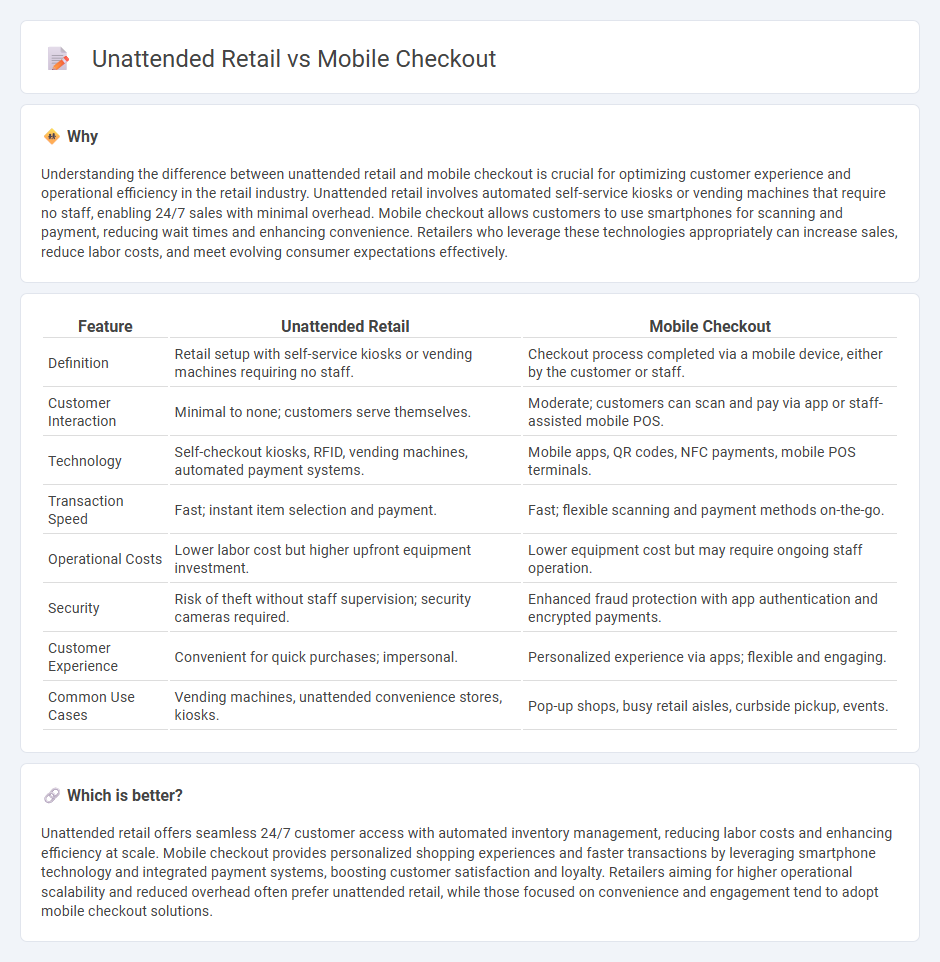
Unattended retail leverages automated kiosks and vending machines to enable seamless product purchases without staff, enhancing convenience and reducing operational costs. Mobile checkout integrates smartphone technology to allow customers to scan and pay for items independently, speeding up the transaction process and minimizing checkout lines. Explore the differences between unattended retail and mobile checkout to discover which solution best fits your business needs.
Why it is important
Understanding the difference between unattended retail and mobile checkout is crucial for optimizing customer experience and operational efficiency in the retail industry. Unattended retail involves automated self-service kiosks or vending machines that require no staff, enabling 24/7 sales with minimal overhead. Mobile checkout allows customers to use smartphones for scanning and payment, reducing wait times and enhancing convenience. Retailers who leverage these technologies appropriately can increase sales, reduce labor costs, and meet evolving consumer expectations effectively.
Comparison Table
| Feature | Unattended Retail | Mobile Checkout |
|---|---|---|
| Definition | Retail setup with self-service kiosks or vending machines requiring no staff. | Checkout process completed via a mobile device, either by the customer or staff. |
| Customer Interaction | Minimal to none; customers serve themselves. | Moderate; customers can scan and pay via app or staff-assisted mobile POS. |
| Technology | Self-checkout kiosks, RFID, vending machines, automated payment systems. | Mobile apps, QR codes, NFC payments, mobile POS terminals. |
| Transaction Speed | Fast; instant item selection and payment. | Fast; flexible scanning and payment methods on-the-go. |
| Operational Costs | Lower labor cost but higher upfront equipment investment. | Lower equipment cost but may require ongoing staff operation. |
| Security | Risk of theft without staff supervision; security cameras required. | Enhanced fraud protection with app authentication and encrypted payments. |
| Customer Experience | Convenient for quick purchases; impersonal. | Personalized experience via apps; flexible and engaging. |
| Common Use Cases | Vending machines, unattended convenience stores, kiosks. | Pop-up shops, busy retail aisles, curbside pickup, events. |
Which is better?
Unattended retail offers seamless 24/7 customer access with automated inventory management, reducing labor costs and enhancing efficiency at scale. Mobile checkout provides personalized shopping experiences and faster transactions by leveraging smartphone technology and integrated payment systems, boosting customer satisfaction and loyalty. Retailers aiming for higher operational scalability and reduced overhead often prefer unattended retail, while those focused on convenience and engagement tend to adopt mobile checkout solutions.
Connection
Unattended retail leverages mobile checkout technology to enable seamless, contactless purchasing without the need for staffed checkouts. Mobile checkout uses smartphones to scan items and process payments, reducing transaction times and enhancing customer convenience in unattended retail environments. This integration drives efficiency, lowers operational costs, and supports touch-free shopping experiences crucial in modern retail.
Key Terms
**Mobile Checkout:**
Mobile checkout streamlines the purchase process by enabling customers to scan items and pay instantly via smartphones, reducing in-store wait times and enhancing convenience. This technology leverages contactless payment methods and secure digital wallets to boost transaction speed and security, driving higher customer satisfaction and increased sales conversion rates. Explore how mobile checkout can revolutionize your retail operations and customer experience.
Mobile POS (Point of Sale)
Mobile checkout through Mobile POS systems enables seamless, flexible payment processing directly on smartphones or tablets, enhancing customer convenience and reducing queue times in retail environments. Unattended retail relies on automated kiosks or vending machines without staff, focusing on self-service technology but lacking the personalized interaction and dynamic payment options Mobile POS offers. Explore how integrating Mobile POS can transform retail operations by combining mobility, efficiency, and customer engagement.
QR Code Payments
QR code payments enhance mobile checkout by enabling quick, contactless transactions through smartphones, streamlining the purchase process in retail environments. In unattended retail, such as vending machines or kiosks, QR codes facilitate seamless payments without the need for cash or card swipes, improving user convenience and operational efficiency. Discover how QR code technology transforms payment experiences in both mobile checkout and unattended retail sectors.
Source and External Links
Mobile Checkout: Drive Sales With a Perfect Checkout Experience - Mobile checkout is completing purchases on smartphones or tablets, designed to be seamless and user-friendly, improving conversion rates by minimizing cart abandonment through streamlined payment and shipping options.
Accept payments on-the-go Chase Mobile (r) Checkout - Chase Mobile Checkout enables businesses to accept credit card payments via smartphone and a mobile card reader with features like contactless payments, next-day funding, and 24/7 support for mobile sales environments.
10 Best Practices To Optimize Your Mobile Checkout - Optimizing mobile checkout is essential as over 70% of shopping carts are abandoned, mostly due to slow load times and cumbersome forms; a smooth mobile checkout process increases conversion and customer loyalty by ensuring speed and simplicity.
 dowidth.com
dowidth.com